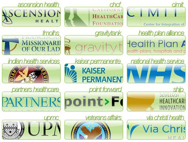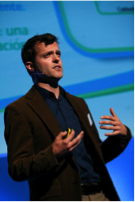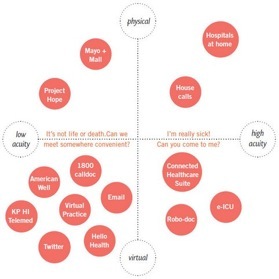Leaving Sight of Land to Invent the Future of Healthcare (Chris McCarthy)
Don't play what's there, play what's not there.
– Miles Davis
How do you start inventing the future? When does hard work, hope, and history rhyme in a way that something really new comes into being? Members of the Innovation Learning Network are discovering the answers.
With the aim of designing the future of healthcare, the ILN network was launched in 2006 with the support of the VHA Health Foundation and Kaiser Permanente (the largest health plan in the US). Members share methods, transfer ideas, and generate opportunities for inter-organizational collaboration.
 Pictured left: ILN member organizations
Pictured left: ILN member organizations

Chris (pictured right) has a dual role: he is a lead at Kaiser Permanente’s Innovation Consultancy (serving as an innovation consultant) and leads the ILN. In both roles, Chris’ goal is akin to the moment in the 1968 Olympics that Dick Fosbury broke the Olympic high jump record by an unimaginable three inches. He re-invented high jumping: the "Fosbury Flop" involved a straight approach, jumping with both feet, and twisting the body 180 degrees looking away from the bar. Before his revolutionary invention, all jumpers faced the bar and launched off one foot.
For ILN members to successfully invent the future, fresh development approaches were required. Members wanted to deepen their understanding of patient needs and learn how to break away from current reality. A synergistic mash up of Design Thinking and Liberating Structures were put into play. Particularly useful LS include Open Space and Social Network Webbing.
Every year since the 2006 inception, Open Space was used during one of the face to face ILN meetings. The purpose was to help ILN members find opportunities for collaboration and set direction for learning.
Open Space suited the action-orientation and “we fail forward” spirit of innovators. Chris says, “I believe playful curiosity is the best way to attract people into this messy work. Open Space gives permission to explore what we know and more importantly what we don’t know. Without exploring unfamiliar territory, most innovations fall short.”
![]() In Open Space sessions, innovators from different organizations found others that shared curiosity regarding “unfamiliar territory. Big questions fueled expansive action-research themes:
In Open Space sessions, innovators from different organizations found others that shared curiosity regarding “unfamiliar territory. Big questions fueled expansive action-research themes:
Virtual Worlds (2006): how could virtual world technology (e.g.,“Second Life”) help invent new rules? This topic cracked open a door to real world applications: localizing disaster planning with real-time Google weather and traffic data; reducing the spread of infection by incorporating special dimensions in training session, rehab for injured veterans stimulating movement with Wii technology, and spreading hospital shift change innovations across the country. Directly and indirectly, ILN members were urging each other on.
Medication Administration (2006): what is the current state medication administration in our hospitals and how can we get to the safest, most human-centered solutions? Over the course two months Kaiser Permanente (KP), Partners, Alegent and Ascension all shared their current state, practices, improvements and innovations. All four systems became immediately smarter. KP went on innovate in the medication administration process which became known as KP MedRite, and then shared the system back with its ILN partners.
 CareAnyWhere (2007-2009): how could the future of health care enable patients to receive care wherever they are (not dependent on traveling to healthcare facilities)? This theme also cracked open a seam that led to an expansive research and application agenda. Radical inventiveness started to unfold in tangible approaches like: hospital-at-home, care at the shopping mall, home visits; and, less tangible care methods like e-ICU, Twitter and Virtual Practice. Eyes opened. What seemed like science fiction (robo-doc) or retro (home visits) started to make practical sense.
CareAnyWhere (2007-2009): how could the future of health care enable patients to receive care wherever they are (not dependent on traveling to healthcare facilities)? This theme also cracked open a seam that led to an expansive research and application agenda. Radical inventiveness started to unfold in tangible approaches like: hospital-at-home, care at the shopping mall, home visits; and, less tangible care methods like e-ICU, Twitter and Virtual Practice. Eyes opened. What seemed like science fiction (robo-doc) or retro (home visits) started to make practical sense.
| Pictured above; Portfolio of CareAnyWhere discoveries. |
Game-ification of Healthcare (2010):
The latest surprising topic emerging in Open Space: how could games help people change their behavior in ways that improve health, prevent disease, or help them live more fully with a chronic disease? Applications discovered include: a virtual reality game called Snow World used to treat burn patients that cannot tolerate more pain medication; Nike +I-Pod “sensor-enabled smart shoes” to help athletes keep boost their performance and health; and, computer games that make it fun for children to learn how to live with diabetes.
While individuals use the games, players are often connected to peers or a community with the same challenges. Game designers demonstrated how technical, clinical, and social motivations can be combined in powerful ways. Skeptics walked way inspired with a wide range of serious applications in hand.
Like other unlikely ILN topics, exploring games turned out to be both serious and seriously fun. The discoveries are “game changing” and each topic rose from humble beginnings. The first Open Space sessions offered only shadowy hints of what was to come.
When we first started the ILN, we weren’t sure what it was, where it was going, or how it would last. Five years later we know it’s the sweet spot of content, technique and friendship that drives us to return year after year,” suggests Chris.
![]() Part of the hidden capability in the ILN is well developed Social Network Webbing via informal networks and relationships. Each member organization has a designated “network weaver,” responsible for matching people to people and people to specific projects. This was one result of detailed social network mapping efforts conducted in 2006 and 2007.
Part of the hidden capability in the ILN is well developed Social Network Webbing via informal networks and relationships. Each member organization has a designated “network weaver,” responsible for matching people to people and people to specific projects. This was one result of detailed social network mapping efforts conducted in 2006 and 2007.
Another result is that many members now have local-internal networks to match the global-external ILN. Chris notes, “A year after we started the ILN, we realized that we didn’t even know who the internal innovators where at KP let alone from the outside world. “Kaiser Permanente’s internal network (dubbed the Garfield Innovation Network or GIN) has grown to 400 members from 5. ILN members realized the members with more robust internal innovation networks were making more practical use of the global network.
Reflections on Open Space
Chris muses,
Open Space is one of those amazing aha’s of when you realize that simple is truly better. Who would have thought a group of people on the fly could construct their own agenda and self facilitate? Open Space works because so rarely are people who gather at meetings ever given the chance to own it, run it, and decide it. Of course with ownership comes responsibility!”
To invent the future of healthcare, Open Space and Social Network Webbing have helped ILN members collectively “leave the sight of land.” A creative mix of new technologies, a strong social network, and a fresh look fundamental health needs are brining the future into focus.
